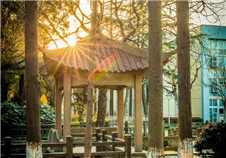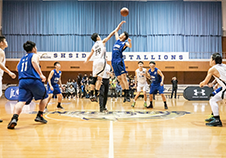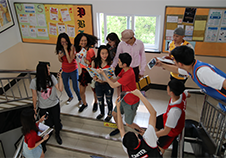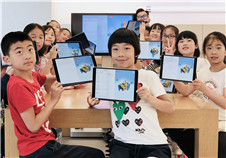
News
Primary School Math Department: Celebrating PI Day
March 14th is Pi Day, named after the commonly used approximation of the mathematical constant pi (π), which is 3.14. On this day, mathematicians and enthusiasts around the world organize events to celebrate this holiday. Celebrants ascribe different meanings to pi, taking part in activities such as eating pi-themed foods and drinks, and playing pi-related games. In addition to some traditional celebrations such as eating pies, students from Grade 1-5 of all campuses in SHSID also experienced various learning activities related to pi. Students enjoyed learning while having fun, gaining mathematical knowledge, and exercising their mathematical abilities amidst laughter.
The announcement of Pi Day activities started a week ago. But what is Pi? Is it everyone’s favorite chocolate pie? Is it the fragrant apple pie? With such questions in mind, first-grade children embarked on a Pi Day journey. The activities began with understanding circles and the mysterious number π. The infinite nature of the number π amazed them, and they proudly recited many decimal places. The children also felt the close relationship between π and circles through Pi Day songs. Creating beautifully crafted flip books deepened students’ understanding of π. They learned that 3.14 represents π, which describes the relationship between the circumference and diameter. Next, they searched for 10 circular objects to make math more relatable to daily life, such as pizza, soccer balls, donuts, clocks, coins, and cookies. Sharing their favorite pie flavors and circular foods awakened their taste buds’ memories. As soon as Pi was mentioned, images of circular cakes and chocolate pies popped into students’ minds, making them drool, and deepening their understanding of concepts related to π and circles. The school bell rang, but the sound of students reciting π continued to echo…



The second-grade children started creating colorful circles filled with mathematical wonders during the preceding weekend. These circles adorned the hallway, featuring mini-biographies of mathematicians, math puzzles, Math Fun Facts, and more. As the children walked by, they couldn't resist stopping to carefully peruse each circle. On International Mathematics Day, which fell on Thursday, the children eagerly attended an "exploration" event wearing clothing and accessories adorned with mathematical elements. To their delight, the teacher had prepared fascinating spirograph sets as gifts! With a large circle enveloping a smaller one and the pen tip fitting into a tiny hole on the ruler, they danced a circular melody on paper, creating intricate and beautiful patterns. Soon, the children discovered that their patterns were similar yet different; even with the same set, a slight change in the starting position of the pen tip resulted in a different design. Why was this happening? Guided by the teacher, the children realized the importance of controlling variables to identify the pattern of change. They adjusted the size and number of teeth on the inner and outer circles of the spirograph, only changing the position of the pen tip each time. Through observation, they noted the similarities and differences in the resulting patterns and recorded their findings. After class, the children happily went home with their exploration results, transforming into little spirograph teachers. They continued their "exploration lessons" with their parents, creating a joyful "Family Math Night."



Third-grade students fully experienced the charm of mathematics on International Mathematics Day. At the beginning of the event, each student randomly received a sector-shaped cardboard. They drew and introduced famous mathematicians and interesting mathematical principles on their sectors. Some children meticulously depicted the profile of Archimedes, explaining how he utilized the principle of buoyancy to drive scientific progress. Others drew the graphical representation of Euler's formula, explaining its important role in math. Then, they ingeniously applied mathematical principles to artistic creation by connecting numbers on the circumference with chords, creating creative artworks. The students also participated in visual illusion experiments, exploring the wonders of circles and deeply experiencing the marvelous application of mathematical principles in visual perception. In addition, teachers carefully planned a series of fun-filled activities, including the popular game of Twenty-Four. This event not only discovered that mathematics is not just a bunch of numbers and formulas but a discipline full of wisdom and creativity. Through participation in these activities, the students not only improved their mathematical literacy, but also developed innovative thinking and problem-solving skills. The third graders have no limits just like Pi!



The fourth-grade students’ Pi Day creations have become a vibrant highlight in the corridors. In the “Pi Marathon” activity, each child was assigned a digit of π and created repetitive patterns corresponding to that digit with their imagination and creativity. In the end, the students’ drawing were connected in order of the digits of π, forming a decorative π-themed corridor. Additionally, the versatile fourth-graders selected their favorite "Pi Day Challenge" from a variety of colorful activities. Little chefs unleashed their creativity by baking delicious and sweet pies at home, crafting food related to π. The young musicians transformed the digits of π into musical notes, playing the delightful melody of π with different instruments. Aspiring artists incorporated π into their artworks, expressing their individual understanding of π with brushes and paper. Poets among them wrote beautiful poems centered around π, while math enthusiasts who love challenges completed Sudoku puzzles composed of Pi digits.



The exciting activities of the fifth grade are in full swing. Through games such as knowledge quizzes, crossword puzzles, and memory competitions, students gained an understanding of the origin of π and related knowledge in a joyful atmosphere. In the fun “measurement lab” segment, children followed along with an engaging picture story book, immersing themselves in the narrative to embark on an adventure measuring the circumference of circles and rescuing the protagonist. They measured the circumference and diameter of various circular objects they brought to school, calculated the ratio between the two, and obtained a consistently unchanging magic number—π. They then verified whether it was close to 3.14. Undoubtedly, the highlight of the fifth-grade activities was the final STEM task— “Wheely Fun.” Students collaborated in groups, drew model diagrams, and built a rolling wheel using modeling clay and bamboo sticks. Finally, they tested the distance the wheel could roll continuously, challenging success if it exceeded 3.14 meters. The students eventually created creatively designed wheels through trial, error, and adjustments. Cheers of excitement rang out from the hallway of the fifth grade. The moment the wheels smoothly rolled out marked the children's moment of growth and accomplishment.



The enriching Pi Day activities concluded amid joyous laughter. Although this annual celebration only lasts two days at school, the spirit of curiosity and exploration embedded in the hearts of the SHSID students will continue to guide them in appreciating the beauty of mathematics!
Written by Thea Chen, Yuanjing Zhang, Yu Lin, Yuchen Xie
Pictures by G1-G5 homeroom teachers
Edited by Cong Luo, Bianca Noguera











